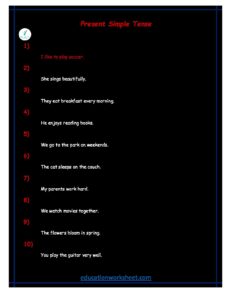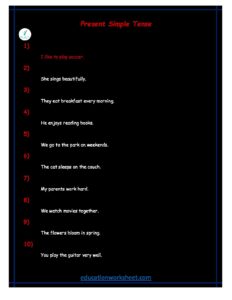how to converting Present Simple Tense negative sentences to positive form
how to converting Present Simple Tense negative sentences to positive form
The English language is a complex system with various tenses, moods, and forms. Among these, the Present Simple tense is one of the fundamental building blocks of English grammar. It is used to describe actions or situations that are habitual, regular, or factual. Understanding how to convert negative sentences in the Present Simple tense into positive ones is essential for effective communication. In this comprehensive guide, we will explore the rules, examples, and strategies to convert such sentences. By the end of this extensive exploration, you will have a solid grasp of how to transform negative statements into positive ones in the Present Simple tense, making your English language skills more versatile and precise.
how to converting Present Simple Tense negative sentences to positive form

Table of Contents
- Introduction
- Understanding the Present Simple Tense
- Converting Negative Sentences to Positive Form a. Basic Rule b. Rule for Auxiliary Verbs c. Rule for Modal Verbs d. Special Cases
- Examples a. Regular Verbs b. Irregular Verbs c. Modal Verbs
- Common Mistakes to Avoid
- Practice Exercises
- Conclusion
how to converting Present Simple Tense negative sentences to positive form

1. Introduction
In English grammar, the Present Simple tense is used to describe actions, habits, general truths, or states of being that are regular, habitual, or factual. When constructing sentences in this tense, it’s crucial to understand how to convert negative statements into positive ones. This skill is not only valuable for everyday conversation but also for writing and comprehending English texts.
2. Understanding the Present Simple Tense
Before delving into the conversion process, let’s briefly review the basics of the Present Simple tense. In this tense, verbs are generally used in their base form (infinitive) for the third person singular (he, she, it), and ‘s’ or ‘es’ is added to the base form. For all other subjects (I, you, we, they), the base form is used.
how to converting Present Simple Tense negative sentences to positive form
Positive Statement:
- I work at a company.
- She works at a hospital.
Negative Statement:
- I do not (don’t) work at a company.
- She does not (doesn’t) work at a hospital.
In the negative form, we use the auxiliary verb ‘do’ or ‘does’ (depending on the subject) followed by ‘not’ before the main verb to indicate the negation.
how to converting Present Simple Tense negative sentences to positive form
3. Converting Negative Sentences to Positive Form
a. Basic Rule
To convert a negative sentence in the Present Simple tense into a positive one, we generally follow this rule:
From Negative: Subject + Auxiliary Verb (do/does) + Not + Base Form of the Verb
To Positive: Subject + Base Form of the Verb
In other words, we remove the auxiliary verb ‘do’ or ‘does’ and ‘not’ from the negative sentence to create the positive form.
Let’s look at some examples:
Negative: She does not (doesn’t) eat meat. Positive: She eats meat.
Negative: They do not (don’t) live in the city. Positive: They live in the city.
how to converting Present Simple Tense negative sentences to positive form
b. Rule for Auxiliary Verbs
In sentences that use auxiliary verbs (e.g., ‘be’ verbs like ‘am,’ ‘is,’ ‘are’), the conversion to the positive form is slightly different. Here’s the rule:
From Negative: Subject + Auxiliary Verb (be) + Not + Main Verb (Present Participle)
To Positive: Subject + Auxiliary Verb (be) + Main Verb (Present Participle)
Here, we only remove the ‘not’ from the negative sentence to create the positive form while keeping the auxiliary verb ‘be’ intact.
Example:
Negative: He is not (isn’t) sleeping. Positive: He is sleeping.
how to converting Present Simple Tense negative sentences to positive form
c. Rule for Modal Verbs
Modal verbs (e.g., can, could, may, might, will, would, shall, should, must) also have their own conversion rule:
From Negative: Subject + Modal Verb + Not + Base Form of the Verb
To Positive: Subject + Modal Verb + Base Form of the Verb
In this case, you only need to remove ‘not’ from the negative sentence to make it positive, leaving the modal verb and the base form of the verb unchanged.
Example:
Negative: They can not (cannot/can’t) swim. Positive: They can swim.
d. Special Cases
There are a few irregular verbs and exceptions in English that do not follow the standard rules for converting negative sentences to positive form. These verbs change their form in both negative and positive statements. Here are a few examples:
- Negative: He has no money. Positive: He has money.
- Negative: I see nothing. Positive: I see something.
- Negative: She goes nowhere. Positive: She goes somewhere.
Understanding these exceptions is crucial, and they are typically learned through exposure to the language and practice.
how to converting Present Simple Tense negative sentences to positive form
4. Examples
Now, let’s explore some examples of converting negative sentences to positive form in different contexts:
a. Regular Verbs
- Negative: They do not (don’t) like coffee. Positive: They like coffee.
- Negative: He does not (doesn’t) speak Spanish. Positive: He speaks Spanish.
- Negative: We do not (don’t) watch TV on weekdays. Positive: We watch TV on weekdays.
b. Irregular Verbs
- Negative: She does not (doesn’t) have any pets. Positive: She has pets.
- Negative: They do not (don’t) go to the gym often. Positive: They go to the gym often.
- Negative: I do not (don’t) know the answer. Positive: I know the answer.
c. Modal Verbs
- Negative: I can not (cannot/can’t) play the piano. Positive: I can play the piano.
- Negative: She may not (mayn’t) come to the party. Positive: She may come to the party.
- Negative: They should not (shouldn’t) eat too much junk food. Positive: They should eat less junk food.
5. Common Mistakes to Avoid
When converting negative sentences to positive ones, it’s important to be aware of common mistakes. Here are some errors to avoid:
- Confusing auxiliary verbs: Ensure that you use the correct auxiliary verb (‘do’ or ‘does’) according to the subject.
- Neglecting irregular verbs: Some verbs have irregular positive forms that do not follow standard patterns.
- Omitting modal verbs: Don’t forget to include modal verbs in the positive form.
- Neglecting contractions: Contractions like ‘don’t,’ ‘doesn’t,’ ‘can’t,’ and ‘shouldn’t’ are commonly used in spoken English.
6. Practice Exercises
Practice is essential for mastering the conversion of negative sentences to positive form in the Present Simple tense. Here are some exercises to help you reinforce your understanding:
Exercise 1: Convert the following negative sentences into positive form.
- She doesn’t like chocolate.
- They don’t live in London.
- He can’t swim.
- We shouldn’t eat too much sugar.
- I don’t have a car.
Exercise 2: Rewrite the following positive
how to converting Present Simple Tense negative sentences to positive form

